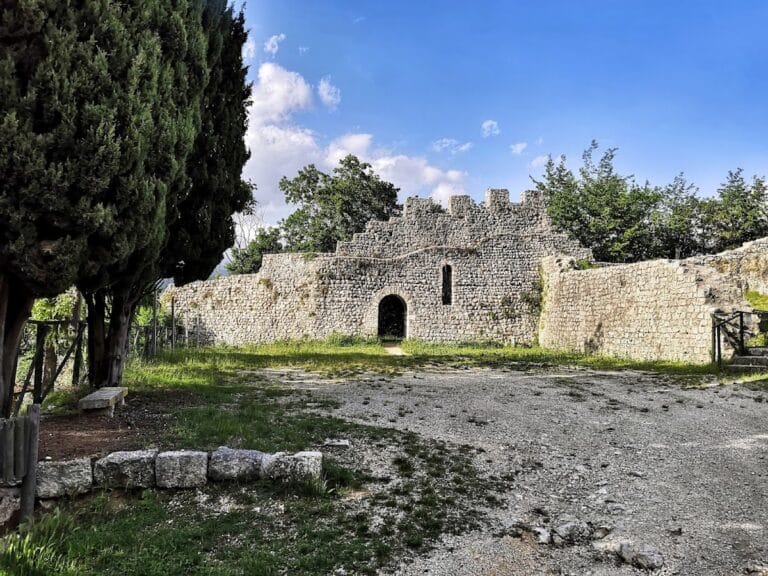Zumelle Castle: A Medieval Fortress in Borgo Valbelluna, Italy
Visitor Information
Google Rating: 4.4
Popularity: Medium
Google Maps: View on Google Maps
Official Website: www.castellodizumelle.it
Country: Italy
Civilization: Unclassified
Remains: Military
History
Zumelle Castle is located in the municipality of Borgo Valbelluna, Italy, and was initially established by the Romans. Constructed around 46 to 47 CE, the fortress was designed to secure Roman authority in the Valbelluna area, which had been conquered during the 1st century BCE. Strategically perched on a cliff overlooking the Terche stream, the castle overlooked an important route that connected the plains to the mountainous region through the Praderadego pass. This path was likely a secondary branch of the Via Claudia Augusta Altinate, a significant Roman road facilitating movement and military control.
During the period of barbarian invasions and the early Middle Ages, Zumelle Castle assumed a crucial role in regional defense as well as in maintaining communication between the towns of Feltre and Ceneda. Local legend attributes the castle’s refounding to Genseric, a trusted advisor to the Ostrogoth queen Amalasuntha. According to the tale, after the queen’s assassination, Genseric settled at the site and fathered twins, a detail believed to have inspired the castle’s name.
In 737, the Lombard King Liutprand granted control of Zumelle to Valentino, bishop of Ceneda. This sparked a conflict with John, bishop-count of Belluno, who already held sway over the territory. The dispute was resolved in 750 through the intervention of King Aistulf. Later, in 963, Emperor Otto I transferred control of the county to the bishops of Belluno, marking another shift in ecclesiastical authority over the site.
In 1037, Emperor Conrad II awarded the castle to Baron Adelfredo. His daughter Adelaide inherited the property, and by the mid-12th century, ownership passed to Countess Sofia da Colfosco, who was married into the da Camino noble family. Subsequently, in 1311, Rizzardo IV da Camino, lord of Treviso, Belluno, and Feltre, undertook a significant reconstruction of the castle, enhancing its defensive capabilities.
Following its conquest by the Republic of Venice, Zumelle Castle was granted in 1358 to the Venetian patrician Zorzi family. This transfer was part of a compensation agreement involving territories lost in Dalmatia and included stewardship over nineteen nearby villages. As part of their duties, the Zorzi family was required to make annual offerings to a local basilica, maintain a representative called a vicar, oversee justice administration, and staff the castle with four salaried men.
The castle’s military relevance declined after it was sacked in 1510 during the War of the League of Cambrai, an event marking the clash between major European powers. The advancement of firearms and a period of Venetian peace further reduced the need for such fortifications. Ownership passed from the Zorzi counts to the Gritti family in 1720, after which the castle fell into disuse and began to deteriorate. It remained neglected until 1872 when the municipality of Mel acquired the property at a public auction for rural purposes.
In the latter half of the 20th century, between the 1960s and 1980s, restoration work was carried out to preserve Zumelle Castle. Unlike other fortresses in the Valbelluna area, the castle was spared from extensive Venetian-era destruction or remodeling, making it one of the best-preserved medieval sites in the region. Since 2014, it has been managed by the Tuscan organization “Sestiere Castellare” and has been opened to the public as a venue for historical reenactments and activities related to the medieval period.
Close to the castle lies the early medieval Church of San Donato, which dates to Lombard times. Its architectural plan features a single nave with three apses—a rounded or polygonal recess at the eastern end of the church. Inside, the church contains an 18th-century altar and fragments of Gothic frescoes. The building is presently closed because of structural issues caused by water damage.
Remains
Zumelle Castle occupies a commanding position atop a steep rock formation overlooking the Terche stream. Its layout includes a defensive ditch carved directly into the bedrock, which encircles the complex as a protective measure. The castle’s structural elements exhibit medieval construction techniques without significant alterations from the Venetian period, preserving its original character.
Central to the site is the keep, or mastio, dating from the 11th century. This stronghold formed the castle’s primary defensive core and served as a residence and last line of defense during sieges. Nearby stands the chapel of San Lorenzo, constructed over an earlier Byzantine sacellum—a small, private chapel or shrine. The chapel contains burials and a sarcophagus, demonstrating the site’s long-standing religious significance across centuries.
Additional defensive features include a fortified tower, surrounding walls, and a moat, all indicative of the medieval military architecture designed to repel attackers. One notable historical element is a stone inscription embedded in one of the castle towers, commemorating a victory by a figure named Ziergen Philistin over an opponent named Ioanninum Azzonis, highlighting the castle’s martial heritage.
Within the castle grounds today, a reconstructed medieval village replicates various functional interiors. This includes a tower house designed to represent medieval domestic and professional life, with spaces such as an apothecary’s workshop, a bedroom furnished in period style, a banquet hall, a kitchen, and a scriptorium—a room used for writing and copying manuscripts. There is also a military armory area and a dedicated museum space, all intended to demonstrate different aspects of medieval living and defense.
Adjacent to the castle, the Church of San Donato presents a unique architectural footprint characterized by its three apses and simple, single-nave interior. The exterior and interior preserve historical features including an 18th-century altar and surviving patches of Gothic-era frescoes painted on the walls. Though currently closed, the church remains a significant testament to Lombard-era ecclesiastical architecture and art at the site.










